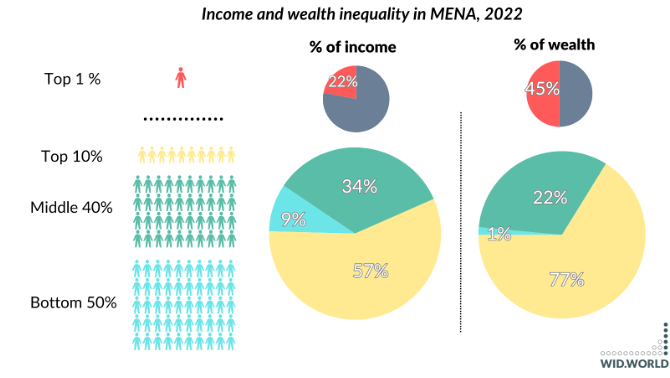Financial Perspective into the Middle East and North Africa
- Nuh Chakkiwala
- Oct 13
- 6 min read

The region of Middle East and North Africa (MENA) has been the topic of discourse on a lot
of developmental issues like labour rights, war reparations, regime changes, political turmoil
and much more. However, in this article I plan to shed light and focus on the financial aspect
of this discourse, by penning down the issues arising in the region on the monetary front, while simultaneously showcasing the active developments happening in MENA for economic
upliftment. For quick comprehension of the task at hand, the examples of war-torn or underdeveloped countries can be looked upon. A requirement of an analysis or at the very least awareness on the matter is needed, providing an understanding of how international
organisations aid in upliftment of the MENA region with focus on capital management as the
foundation of development. This is the stepping stone in achieving a greater financial literacy
and independence for the region and the potential future labelling of these nations as developed and sustainable, finally pulling them out of the category of aid requiring developing or underdeveloped nations.

Economic development leads to a positive growth in standard of living, which ideally and
subsequently should lead to greater human rights development, social harmony and overall
prosperity in a country. A method to achieve this seemingly utopian idea is progressive
realisation, which is a term used for progressive development in accordance with available
resources. (Marks 10) According to the International Covenant on Economic, Social and
Cultural Rights (ICESCR), progressive realisation highlights a state's duty to proactively work
toward achieving rights. In order to guarantee that countries with limited resources make
commitments to the advancement of human rights, this entails developing strategic plans with
the aid of international cooperation and policy reforms. Such frameworks for gradual
improvement are attempted to be incorporated into national development plans, such as Egypt's Vision 2030.
On the topic of income, a majority of the Arab nations are categorised as middle-income
developing nations, such as Egypt, Morocco, Tunisia, Jordan and Lebanon. Meanwhile, there
are low-income countries in the region such as Somalia and Sudan. The diversity in range of
income is displayed in the index prevalent in the human rights index as well, although not
parallelly but rather randomly. Although after review of the nation’s political and economic
history it can be understood where the decline in human rights commences or peaks. Another
major aspect of providing humanitarian aid is funding to sustain that very aid, which in the
case of the MENA region and the larger list of vulnerable countries around the world is deemed insufficient to cater to all the needs. This effectively shows a disbalance in the demand of aid and supply of resources, creating a storm of severe impacts in these nations. (Rescue.org, 2025) The financing of international aid is becoming more and more politicized, with strategic interests frequently dictating aid distribution over humanitarian necessity. Conditional aid that may not always be in line with human rights priorities is frequently given to MENA nations that are experiencing civil war or geopolitical unrest. Additionally, the funding gap has widened due to reluctance of potential donors and increase in worldwide financial concern, which primarily impact long-term developmental aid rather than immediate crisis response.

A case study to be taken to observe the recent state of the abuse of financial rights in the MENA region is the treatment of labour by state of Qatar during the construction of stadiums for FIFA 2022. (Human Rights Watch, November 14, 2022) Workers were tied to employers and subjected to extreme heat conditions and long working hours, while also facing delayed or withheld payments. Compensation to the families for deaths was considered inadequate, with FIFA also under heat due to being a complacent enabler to the human rights violations in the country. Even though Qatar is labelled as a high-income country, it ranks low in the human rights index, being a clear testament to how income isn’t the only indicator of societal welfare.
Now, what measures can be introduced by higher-income countries with greater standard of
living within the MENA region to promote stability and development in the region, particularly
through the means of international organisations? There are various international organisations formed by the Arab countries themselves that aim for cooperation and economic development in the region, such as the Gulf Cooperation Council, which includes the relatively better off countries in the Arabian peninsula, the Arab League, who has 22 member states from the region, and on a greater scale, the Organisation of Islamic cooperation, which is an organisation that encompasses all the states of the Muslim world, majorly based in but not limited to the MENA region. These organisations have one of their primary focuses be the economic growth and cooperation within their members. The Gulf Cooperation Council (GCC) for example, has been contributing to the development of human rights and overall growth of the MENA region by providing generous financial support through the World Bank and its multi-donor trust funds (MDTF). (World Bank, 2025) The Arab Charter on Human Rights also includes the Arab Human Rights Committee, another significant initiative worth mentioning. It is still criticised for its ineffective enforcement capabilities, but it is a step in the right direction for internal accountability systems. It is possible to lessen reliance on interventions led by the West and promote more culturally aware, locally relevant solutions to concerns by promoting greater involvement and openness in these regional institutions. Looking at the statistics of Human Development Index (HDI), a stark distinction between gulf countries and conflict-ridden countries is illustrated, which even from the layman’s perspective showcases the ability of such high growth nations to assist their neighbours in the region. (UNDP Human Development Data Center, 2023)

However, the influence of global international organizations and international provisions to
assist have not been absent in the region. The United Nations is the largest organization
involved in humanitarian aid, and its Universal Declaration of Human Rights has multiple
provisions laid out as guidelines to follow for nation-states, but violations of this declaration
are not uncommon in the MENA region. Violations on the basis of corruption, terror endorsement, bribery, tax evasion, money laundering, etc. are the most commonly prevalent in affected states. Attempting to provide substantial aid to these nations is an ongoing and ever-present process, where supporting organisations like the UNHCR, UNICEF, World Bank and multiple NGOs participate and volunteer to address and mitigate these issues. (UNOCHA,
2025) Taking the example of a non-governmental organisation (NGO) that works towards
fighting inequality, we can further understand and examine the crucial support of humanitarian
organisations. Oxfam International is an NGO that focuses on Climate Action, Economic and
Racial Justice, Humanitarian Response, Women’s Rights and Gender Justice, putting it all
under the branch of fighting inequality. Their presence is seen in seventy-seven countries, out
of which nine are part of the MENA region. These include Algeria, Tunisia, Egypt, Yemen,
Iraq, Jordan, Palestine, Lebanon and Syria. Partnering with local organisations, Oxfam supports sustainable livelihoods, gender equality, entrepreneurship and much more. Support and aid, no matter how minute or insignificant, invariably contributes to the gradual realisation
of development goals, hence the importance of NGOs in this field of human rights upliftment.
(Oxfam, 2025)

The upcoming future calls for both internal and external reforms in governance, with a primary
focus on equality, justice, and dignity while keeping in mind economic reconstruction. Policy
frameworks must be adaptable enough to take into account regional socio-cultural contexts,
while still making sure universal human rights are respected. Governments ought to support
legal institutions, ensuring inclusive representation in politics, and also empower society to
observe and report abuses. International organizations that assist human rights development
through financial support must also review their aid frameworks to make them less conditional, more culturally sensitive, and generally more effective. Ultimately, by reducing migration pressures, fostering peace, and supporting sustainable development in a vital but unstable region that provides connectivity all around the world, the MENA region's human rights advancements stand to benefit not only its citizens but also contribute to global stability.
To conclude, the Middle East and North Africa are a diversely rich yet troubled collection of
states that make up the region. Concerning financial aid for human rights, the place has seen
various hikes of political, social and economic turmoil which affects the welfare and general
standard of living for the people residing there. The need to focus on and provide resolutions
for MENA is a constant ask, hence the question of absence or incompetence of international
cooperation arises when viewing the situation of the region. A multi-faceted approach must be taken when tackling with the issues of the region, taking into account the promotion of
humanitarian action, enhancement of operational capabilities and more. Such initiatives can
slowly but surely realise the steps to reach the goal of a prosperous world.



Comments